Note: I still have a few installments to make from my November trip out to Joshua Tree. Here's one of them!
So, when I headed away from the BLM land, site of the JTree SushiFest, it was about 10am. After heading into town, waiting...and waiting...and waiting for a shower(when finally a nice, clean couple stumbled out the door with big grins on their faces), it was after noon. I quickly went to set up a site in Hidden Valley(where, as I had hoped, I got the Stem Gem site - #23). My partner for the next day was in Jumbo camp so I needed to go leave him a note, and I figured I'd spend the rest of the daylight taking a drive down toward the southern part of the park.
And so, after dropping the note, I headed back down the road and turned right at the road that heads towards the Cottonwood entrance. This area of the park I had never been through, and had been told it's interesting how the land transitions to a more lush terrain.
The person had told me there were a different sort of cactus in the area, very unlike what I would see in the sections of the park most frequented by climbers. I had never heard of the type of cactus he mentioned, and was not all that familiar with much beyond the Prickly Pear and Barrel catus' anyway, so what I was imagining was the giant saguaro. I couldn't wait to see these icons of wild west lore.
As I headed down the drive, I did notice the subtle shift in colors and textures and as I rounded a bend, suddenly I saw hundreds upon hundreds of the cutest little cacti imaginable! I wanted to stop and get out and walk amidst the friendly-looking fellas. Really. They were that inviting....
But a road sign said "no!" and also mentioned a "Cholla Cactus Garden" coming up, where presumably one could park their vehicle and get up close and personal. Even though I'm not a huge fan of taking the "tourist trail," I felt it would be okay this time, since these were an additional surprise on my way to the big cacti.
The road wove circuitously amidst these fields of cacti, first on one side and then the other, and then the entrance to the gardened area appeared. I pulled over, got my camera out and headed down the path along with 3 or 4 others who had happened along at the same time.
There is a large WARNING sign as you enter the site, telling you these cacti may LOOK friendly, and they may have been nicknamed "Teddy Bear Cactus," but it was all a ruse.... Apparently, the quills practically jump off and spear you(hundreds of micro jabs at a clip) if you so much as wander within their airspace. That's an exaggeration, the sign says, but it seems so, because the spines are so tiny that you don't realize you've gotten too close until... you have gotten to close. The sign warns, very clearly, to keep children and/or animals roped in, and that removal of the barbs is tedious, difficult and worst of all, painful.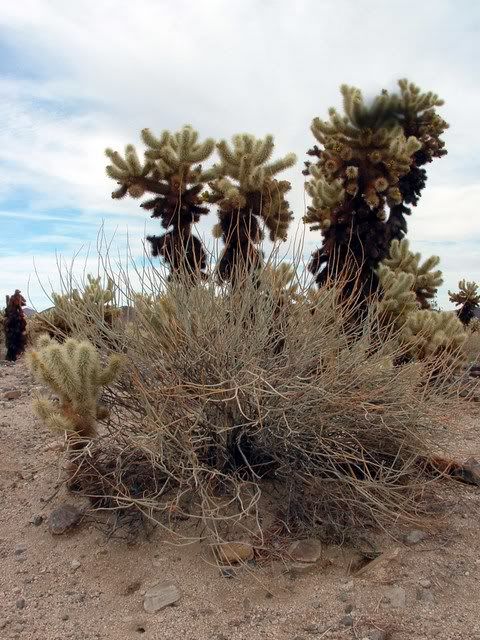
Here's what the famous Cholla, or Teddy Bear Cactus, looks like. Notice the overgrowth of brush at the base of the dried bush in front? What looks like dark patches? If you've been to Jtree, you've probably noticed this around a bit. I always thought it was that the wind blew loose bits of dirt, dry twigs and stuff, and when they snagged on things, eventually the mess would build up, looking thusly... Wrong. The piles of junk(literally) are the homes of desert packrats, who will take whatever they can find, and build a beaver-like den. This photo is actually not a very good example. In another installment of the trip, where I visit an abandoned mine, you will see what I'm talking about.... I hope I'll get to that sooner than I did on this page.
When one rat moves out, another will take up residence, and there are actually some rats nests in Josuha Tree that are more than two thousand - two THOUSAND - years old! The nests have multiple entrances, and the sharp, barb-like branches of fallen desert fauna allow for a great protective barrier. The small rodents can race between the sabres, whereas a larger animal, in hunt of the rat, will get poked in the eye, nose, tummy, and/or foot if they try to dig in!
After learning about the pack rat homes, I started seeing them EVERYWHERE, as I wandered around this time out in the park.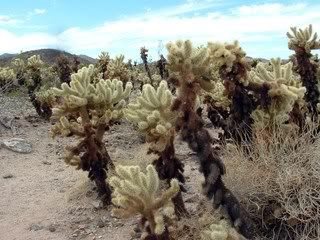
The bottoms of the Teddy Bear cactus die off, but remain solid enough to support the upper sections of the plant, as you can see here. The appearance is that of having had a fire sweep through, but that's not the case.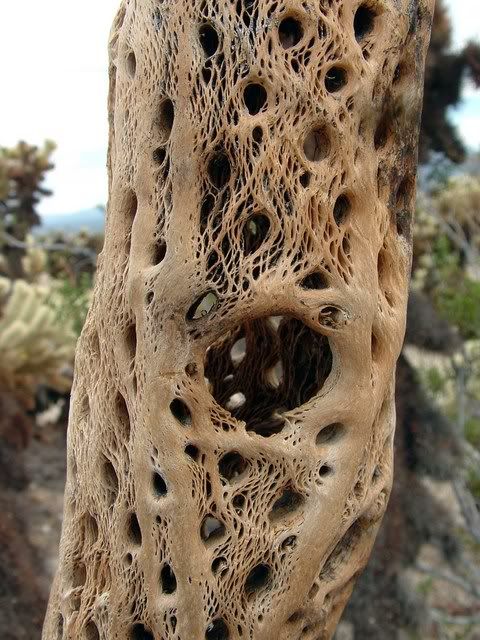
Here is a close-up of a Cholla that has been weathered for who knows how many years. The dry air decreases the rate of decomposition so drastically that a plant one sees one year may very well be there the next year, in exactly the same condition. That's a good example to show just why it's really very important that we take care in these type of environments. One might think tossing a banana or an orange peel aside as we stop trailside for a snack is okay, but how long will that trash remain? The timeframe is measured in years. 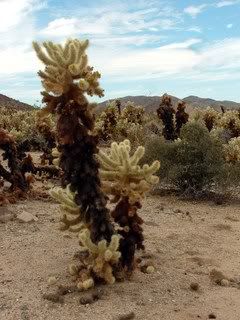
Here you can see the dead base/living top again, but if you look on the ground, surrounding our Teddy's, you'll notice what looks like fallen parts of the cactus. Someone has been out abusing them, maybe some redneck striking them with a stick, is a reasonable first impression. But that's not the deal. The Cholla cactus is made up of a number of delicate, jointed parts, and the slightest breeze tears them away, depositing them nearby. A coyote brushing aside a low-bearing cactus might get a few pods snagged in their fur and carry them who knows where before they come off to rest.
Interestingly, this is part of the Cholla's adaptive evolution. It's how they regenerate! Amazingly, the spiny pods will take root very quickly and soon enough, a new Cholla is growing from that singular discarded bit. Here's one of them up close. The rock shown is about the size of an average man's fist.
The Teddy Bear Garden was a really nice exhibit, and I am glad I stopped. All the information I presented above is posted in a small pamphlet available at the garden's start, with a numerical index that helps you identify the various things to look for. I never would have found any of this out had I not taken this self-guided tour.
I got back in the car, happy with the detour, but still on the hunt for those giant cowboy cacti! As I drove along the road, I noticed pretty flowers and lots of greenery carpeting the desert floors.
Suddenly - I saw something strange! Giant cacti for sure, but of a different sort than I'd ever imagined... These succulents were the size of trees, and looked like the sort of plants one finds in a tropical fish tank. Several long, swaying tentacle-like branches emanating from a common base at the ground. WOW - They were magnificent!
What can I say!? The Ocotillo are so cool, and so far from what I would have expected to see. Here
is a page telling a bit more about them, as I really know nothing myself. 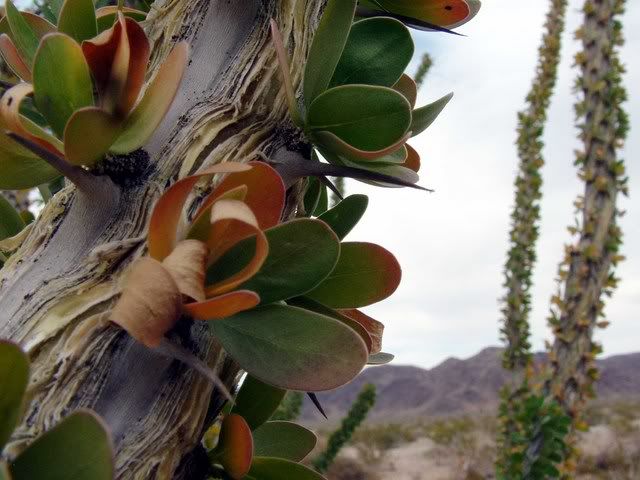
Here's a partially dried out section, close up. How beautiful!
As I mentioned, I saw some beautiful flowers along the way, and though I didn't seem to be having a very good photographer's day, I did manage to get a few to share. The size of this cluster of purple flowers was about three inches in diameter - the photo is actually larger than life-size.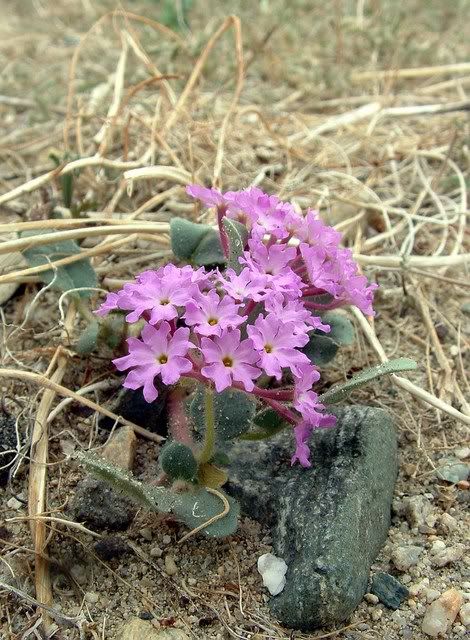

Here's a stunning beauty commonly found along the roadsides, and not just in this particular area. I don't know anything about the plant, but it differs from most desert flowers in that it almost seems like something found in a woodland environment. The actual flower is large, which also seems a paradox, in a land where water is so precious that living things seem to stay small in an attempt to ration the supply. In contrast, this plant seems oblivious to the drought-like conditions!
I wish I'd taken some shots of the mountains in that area, but I knew I just didn't have the equipment, patience and skill to capture an interesting image. What I learned, though, was that the fertile base blanketing the area was actually topsoil which had flowed down along weaknesses in the massive mountains so long ago. In the way a glacier is a giant frozen river coming onto a flat plane, the same had happened here, but the ice was swathes of silted rock instead, creating wondrous wide avenues amidst the formations.
The Cottonwood road is something that anyone interested in geology would probably like to experience, so if you have a rest day next time you are out climbing in Josh, I can definitely recommend taking the drive out there. There are a few established hiking trails, too, though I don't have any details.
~~~~~~~
If you enjoy my blog and would like to subscribe through RSS, you can click the FeedBurner Badge here. Thanks for your support! ![]() Subscribe in a reader
Subscribe in a reader






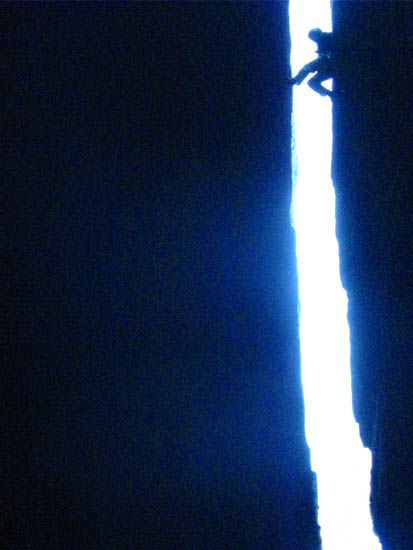
2 comments:
Terrie,
The plant with the giant white flowers is of the genus Datura (there are a number of species). Closely related to jimson weed as I recall.
We have a couple in our yard that we allow to reseed each year. The white flowers attract moths and bloom during the night, closing shortly after sunrise. The seed pods then develop from where the flower falls off and look a lot like chestnut pods, green and spikey, that is. The seed pods on your plant have long since released seeds and turned brown from what I can see.
The flowers are also very fragrant (as you might expect, blooming at night).
Tim s
Thanks for that information, Tim. I wish I'd stopped to smell the (desert) rose now! Next time that will be on the 'to do' list. Speaking of which - soon enough it will be time to start planning for it. I think I may head out the second week in April.
Post a Comment